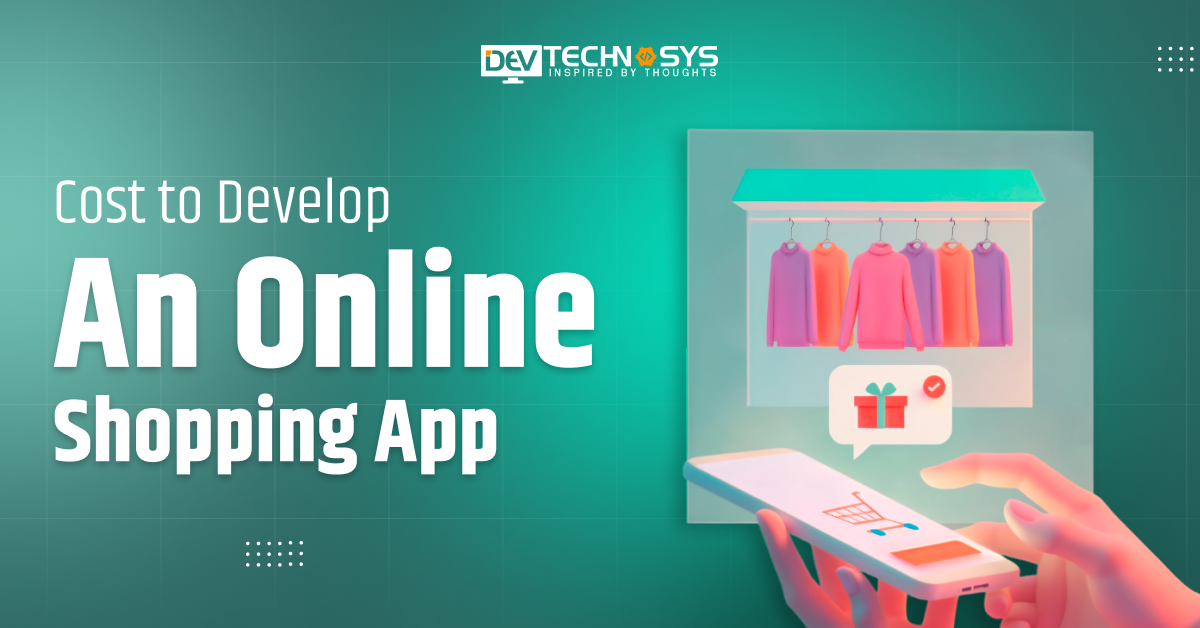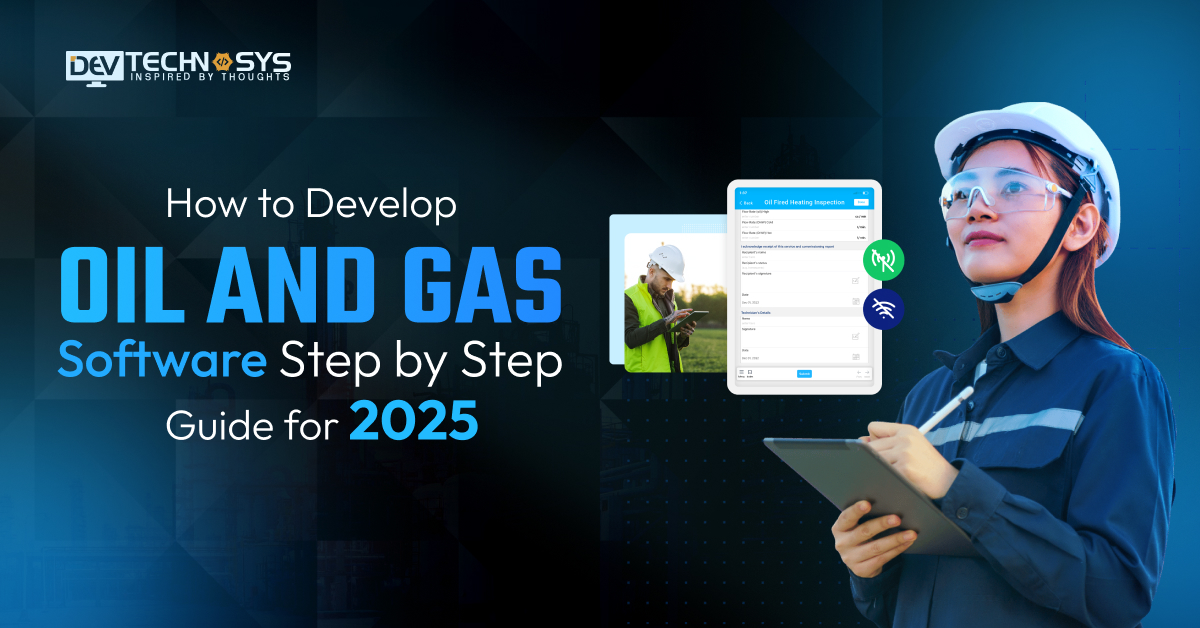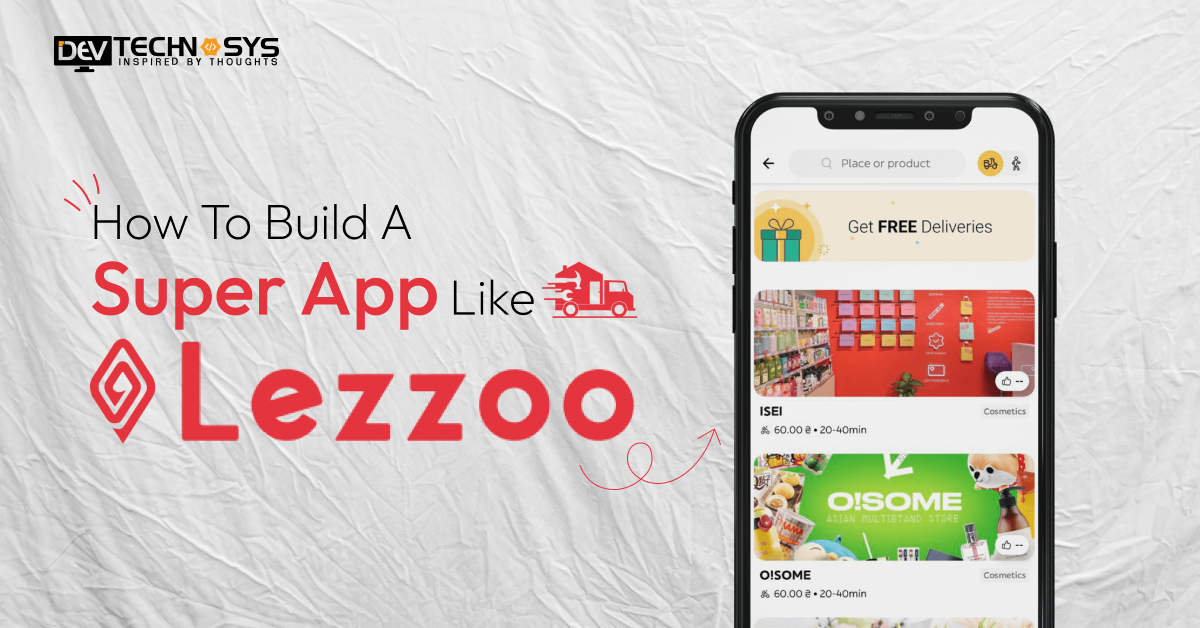You also know that there are many online shopping applications that reduce offline shopping and attract customers by giving them discounts and cashback offers. That’s why the demand for online shopping applications is increasing; I think there is no one who doesn’t know about Amazon, Temu, and Shein.
As per the global market, the online shopping applications market was valued at around $205.32 billion in 2023, and is projected to grow to $591.63 billion by the end of 2031.
This data clearly indicates how rapidly these applications are growing and how they provide a lucrative opportunity for businesses.
Do you also want to transform your offline shopping store into an online shopping application? But you don’t know how much it costs. No need to go anywhere.
Just read this blog step by step to explore how much does it cost to develop an online shopping app and what factors can affect the overall development cost.
What is an Online Shopping App?
An online shopping app is a mobile application that enables users to explore, choose, and buy items or services using their smartphones or tablets. It includes services such as product search, extensive listings, safe payments, and order tracking. If you build a shopping application, it provides a seamless, on-the-go shopping experience, allowing businesses to reach more customers and simplify the purchasing process digitally.
- Product Browsing & Search
- Order Tracking
- AI-based Product Recommendations
Market Analysis of Global Online Shopping Applications
- The market for e-commerce apps was estimated to be worth $205.32 billion in 2023 and is expected to reach $591.63 billion by the end of 2031.
- As per the ground level report, the shopping applications market is expected to increase with a compound annual growth rate of 2% from 2024 to 2031.
- By 2032, North America is expected to have the greatest market share, with a projected value of 0 USD billion.
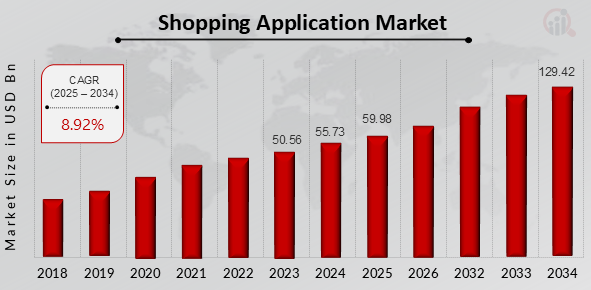
- By 2032, the grocery application category is expected to be worth $32.0 billion USD.
- By 2032, the APAC area is expected to have grown significantly, from 0 USD billion to 18.0 USD billion.
10 Popular Online Shopping Applications
Of course! This is a thorough table that lists 10 well-known digital store apps together with information on their ratings, download counts, launch years, and platform accessibility:
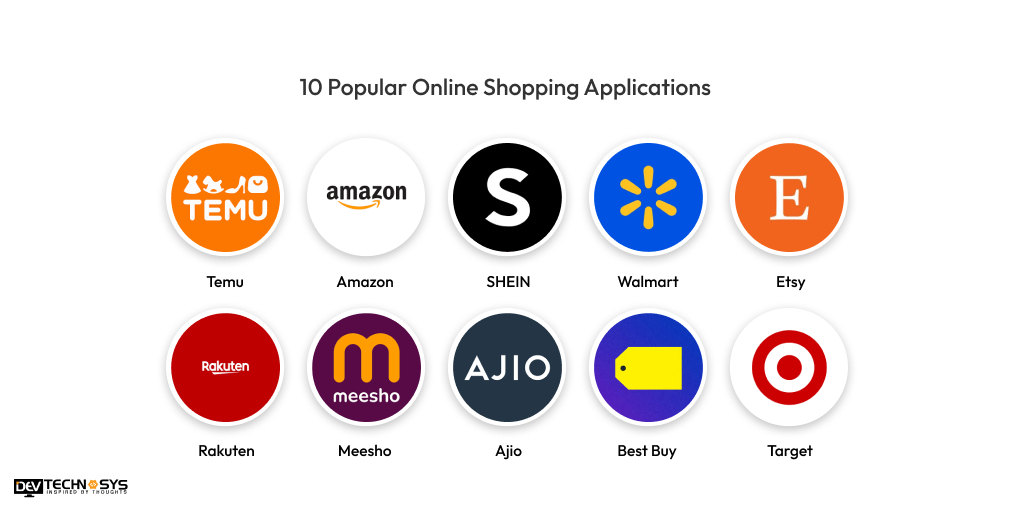
App Name |
Downloads |
Stores Ratings |
Launch Year |
Platform Availability |
| Temu | 500M+ | 4.7 | 2022 | Android, iOS |
| Amazon | 500M+ | 4.4 | 2013 | Android, iOS |
| SHEIN | 500M+ | 3.9 | 2008 | Android, iOS |
| Walmart | 100M+ | 4.5 | 2009 | Android, iOS |
| Etsy | 50M+ | 4.5 | 2005 | Android, iOS |
| Rakuten | 50M+ | 4.2 | 1997 | Android, iOS |
| Meesho | 500M+ | 4.2 | 2015 | Android, iOS, Web |
| Ajio | 50M+ | 4.3 | 2016 | Android, iOS |
| Best Buy | 50M+ | 4.4 | 2009 | Android, iOS |
| Target | 100M+
|
4.8 | 2012 | Android, iOS, Web |
Why Businesses Invest in Online Shopping App Development?
Businesses are spending more money on e-commerce development solutions in today’s digitally first world in order to stay competitive and satisfy changing customer needs. Due to consumers’ preference for the ease of buying from their cellphones at any time and from any location, mobile commerce is expanding quickly.
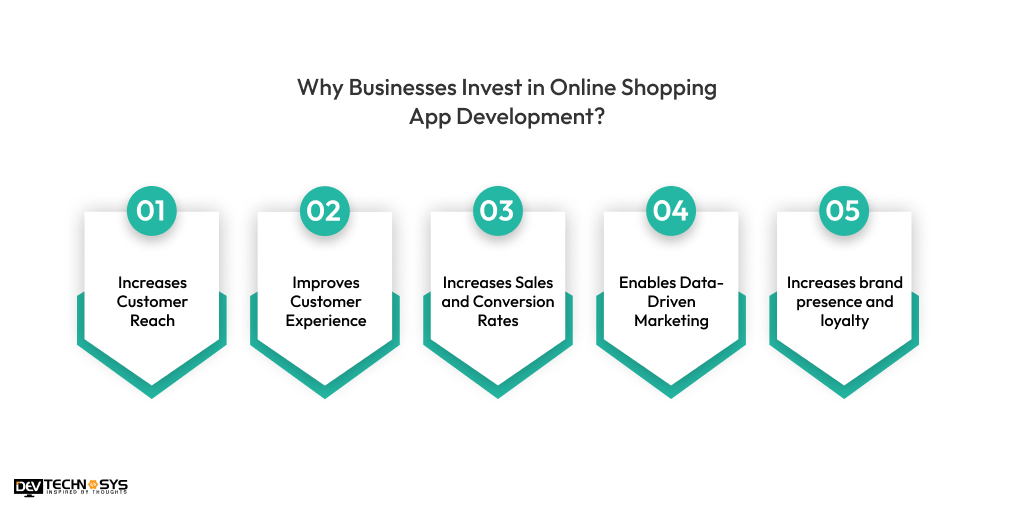
1. Increases Customer Reach
Mobile applications allow businesses to reach a larger, more tech-savvy audience that prefers to purchase on their smartphones. Apps, with their 24/7 availability, location-independent access, and push alerts, let businesses expand into new markets, increase awareness, and attract more consumers than traditional or web-only platforms.
2. Improves Customer Experience
Apps offer a quick, easy, and personalized buying experience. Shopping is more convenient with features like remembered preferences, real-time tracking, and secure payments. A seamless user journey increases happiness, repeat purchases, and brand loyalty, resulting in much higher long-term customer retention.
3. Increases Sales and Conversion Rates
Apps eliminate friction in the purchasing process by providing simplified interfaces, one-click transactions, and smart product suggestions. This convenience encourages impulse purchases, reduces cart abandonment, and greatly increases conversion rates when compared to websites or offline methods.
4. Enables Data-Driven Marketing
Online shopping app development solutions capture user data such as browsing habits, purchase histories, and interaction trends. Businesses utilize this to generate targeted campaigns, tailored offers, and better product suggestions, resulting in more relevant marketing, more engagement, and greater ROI.
5. Increases brand presence and loyalty
Having a branded app makes your business visible on consumers’ phones on a regular basis. Custom features, unique discounts, and loyalty programs strengthen emotional relationships with customers. Apps promote brand identification and provide organizations with a direct, controllable route to foster connections and boost lifetime customer value.
How AI Can Help Online Shopping Applications?
- AI analyzes user behavior to suggest products, improving relevance and boosting sales through tailored recommendations.
- AI enables voice, image, and predictive search, making product discovery faster and more intuitive for users.
- AI-powered chatbots offer instant customer support, answer queries, and guide users throughout the shopping experience.
- AI predicts product demand using historical data, helping businesses manage inventory and reduce overstock or shortages.
- AI evaluates reviews and feedback to understand customer sentiment, helping improve products and customer service strategies.
7 Basic Steps to Develop an Online Shopping App
Build your own online shopping app to reach customers anytime, anywhere. From product browsing to secure checkout, deliver a seamless, user-friendly shopping experience. Boost your brand, increase sales, and stay ahead in the competitive e-commerce market with a custom mobile shopping solution tailored to your needs. So, here we provide the Shopping or POS app development process:
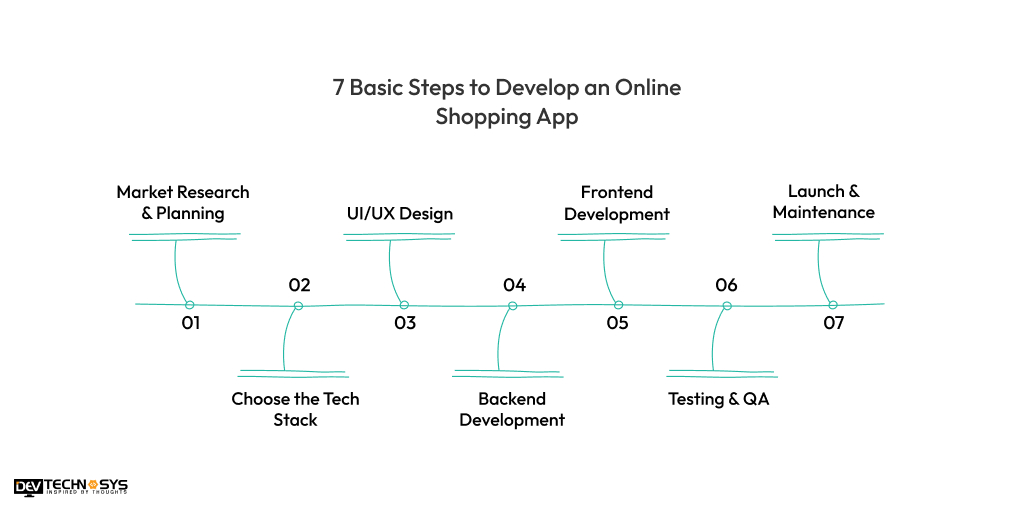
1. Market Research & Planning
Analyze your target audience, competitor apps, and market trends. Hire shopping application developers to define your app’s unique selling points, core features, and monetization strategy. Outline user needs and preferences to build a solution that solves real problems. A clear, data-backed business plan is the foundation of a successful eCommerce app.
2. Choose the Tech Stack
Select the right technologies based on your platform (iOS, Android, or cross-platform). Popular stacks include React Native, Flutter, or native Swift/Kotlin. Ensure backend scalability with frameworks like Node.js or Django. Choose secure, performance-optimized tools for database management, APIs, and payment gateways to ensure smooth and secure operations.
3. UI/UX Design
You can hire an e-commerce development company to create intuitive, responsive, and visually appealing user interfaces. Focus on seamless navigation, clear calls-to-action, and accessibility. Wireframes and prototypes help visualize user flow and identify friction points. A great design enhances user engagement and drives conversions by delivering an enjoyable and frictionless shopping experience across all devices.
4. Backend Development
Build the server-side architecture to handle user data, product inventory, orders, and payment processing. Integrate secure APIs, authentication, and real-time databases. Prioritize scalability and reliability. Cloud services like AWS or Firebase can optimize performance and uptime. Your backend ensures the app’s functionality runs smoothly behind the scenes.
5. Frontend Development
Hire experienced designers from a shopping app development company to turn UI designs into functional screens using your chosen framework. Connect frontend with backend APIs to enable dynamic content, user authentication, and checkout functionality.
Ensure responsiveness across devices, smooth animations, and fast load times. Regular testing ensures consistent user experience and avoids broken flows or visual glitches.
6. Testing & QA
In the second last stage of make an online shopping app, conduct thorough testing: unit, integration, usability, and security testing. Identify and fix bugs, verify performance under load, and ensure compliance with platform guidelines. Involve real users in beta testing to collect feedback. A polished, bug-free app is crucial to gaining user trust and avoiding negative reviews post-launch.
7. Launch & Maintenance
In the last stage of development, consult with an professional Android app development company to deploy the app to app stores with optimized descriptions and visuals. Monitor performance, user feedback, and analytics to spot issues early.
Regularly release updates with improvements and new features. Offer responsive support to build customer loyalty. Long-term success relies on continuous improvement and adapting to user behavior and market trends.
The Cost to Develop an Online Shopping App
The cost to develop an online shopping app varies based on features, platform, and developer rates. A basic app may cost $8,000–$15,000, while a feature-rich version with advanced functionalities like AI, real-time tracking, and multiple payment options can range from $20,000 to $25,000 or more.
Costs also depend on whether it’s developed for iOS, Android, or both. Additional expenses include backend development, UI/UX design, maintenance, and third-party integrations. Hiring a development team from regions like Eastern Europe or Asia can lower costs without compromising quality.
Cost to Build an Online Shopping App
Online Shopping App Development
|
Estimated Cost |
Time Frame |
Basic App Development
|
$8000 – $12000 | 2 to 6 Months |
Mid-Premium App Development
|
$14000 – $19000 | 6 to 8 Months |
High-Premium App Development
|
$25000+ | 9+ Months |
What Are the Key Factors That Affect Online Shopping App Development Cost?
The cost to develop an online shopping app in UAE is influenced by factors such as app complexity, features, platform (iOS/Android), design, integrations, backend development, location of developers, and ongoing maintenance. Customization, security features, and third-party services also impact overall cost to build an online shopping app.
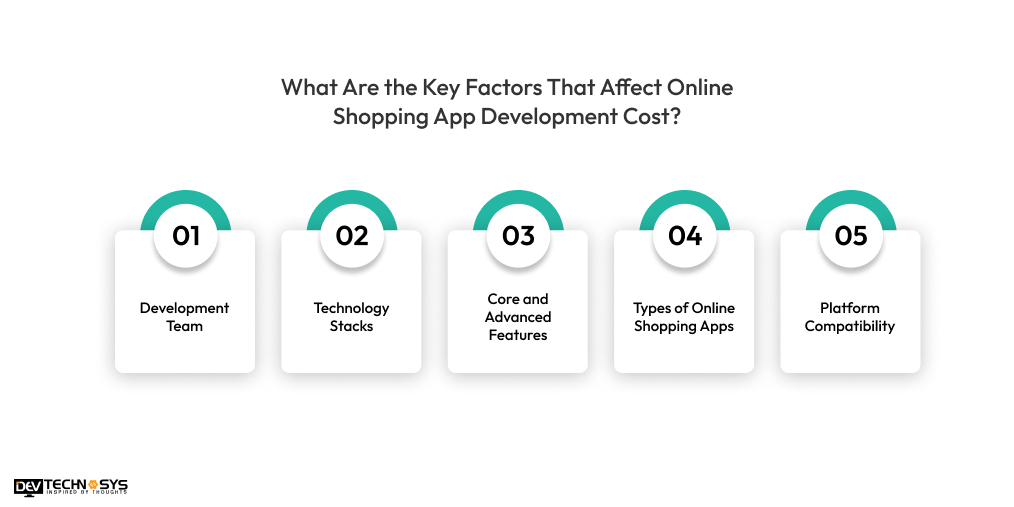
1. Development Team
The development team’s experience and location have a significant impact on the cost of development. Experienced developers in North America and Europe may demand higher rates, but outsourcing to India or Eastern Europe might lower expenses while keeping quality, influencing the final cost to create a mobile app.
Developers Experience level |
United States |
United Kingdom |
Southeast Asia |
UAE |
| Junior-level | $15 – $25 | £14 – £24 | $12 – $22 | $18 – $28 |
| Mid-level | $30 – $50 | £27 – £44 | $25 – $35 | $35 – $50 |
| Senior-level | $60 – $80 | £50 – £65 | $40 – $55 | $55 – $75 |
2. Technology Stacks
The choice of technology stack has a substantial influence on development costs. Modern, scalable alternatives, such as React Native or Flutter, can cut expenses by enabling cross-platform development. In contrast, selecting native development for iOS and Android separately raises costs owing to the necessity for separate codebases, testing, and resources.
Cloud Storage |
AWS, Microsoft Azure, Google Cloud | $1,000 – $3,000 |
Backend Development |
Django, PHP, Nodejs | $4,000 – $10,000 |
UI/UX Design |
Sketch, Adobe XD | $4,000 – $7,000 |
Payment Gateway |
PayPal, Stripe | $4,000 – $8,000 |
Security |
SSL, Biometric, Two-factor Authentication | $1,500 – $4,000 |
Project Management |
Jira, Trello, Asana | $1,000 – $3,500 |
3. Core and Advanced Features
Standard features include product listing, shopping cart, and checkout, but sophisticated features like AI-powered suggestions, live chat, and augmented reality (AR) raise development expenses. The iOS app development cost is directly influenced by the complexity and customisation of these features, as implementing them requires more time, resources, and skill.
Basic Features |
Estimated Cost |
Advanced Features |
Estimated Cost |
| User Authentication & Registration | $5,000 – $8,000 | Voice Search | $5,000 – $9,000 |
| Product Catalog | $4,000 – $6,000 | Social Sharing & Reviews | $2,000 – $5,000 |
| Search & Filters | $7,000 – $10,000 | Live Chat & Chatbots | $10,000 – $13,000 |
| Shopping Cart & Checkout | $4,000 – $7,000 | Loyalty Programs | $8,000 – $10,000 |
| Order Management | $9,000 – $11,000 | Multi-vendor Support | $9,000 – $14,000 |
4. Types of Online Shopping Apps
Costs vary depending on the type of internet shopping app. A simple marketplace app with few features is less expensive than a multi-vendor marketplace or a specialized app (e.g., groceries, fashion) with unique features such as location-based services, inventory management, or real-time updates, which necessitate more complicated development and infrastructure.
Types of Online Shopping Apps |
Cost Estimation |
| Marketplace App | $10,000 – $15,000 |
| Single-Vendor App | $13,000 – $20,000 |
| Grocery Shopping App | $10,000 – $25,000 |
| Fashion & Apparel Shopping App | $12,000 – $18,000 |
| Wholesale/ B2B Shopping App | $15,000 – $22,000 |
5. Platform Compatibility
The platform chosen for the app (iOS, Android, or both) influences the online shopping app development cost. Building for many platforms incurs additional expenses owing to the necessity for cross-platform tools or distinct codebases. Ensuring compatibility with multiple screen sizes, OS versions, and device kinds necessitates more development and testing, which raises the cost of online shopping app development services.
Development Platforms |
Estimated Cost |
| Web Apps | $15,000 – $22,000 |
| Native Apps | $20,000 – $30,000 |
| Hybrid Apps | $18,000 – $27,000 |
How to Reduce the Online Shopping App Development Cost?
To minimize ecommerce app development services costs, opt for cross-platform frameworks, prioritize essential features for the MVP, use pre-built templates or modules, outsource to cost-effective regions, and maintain a clear project scope. Regular communication and agile development also help avoid unnecessary revisions and keep budgets under control.
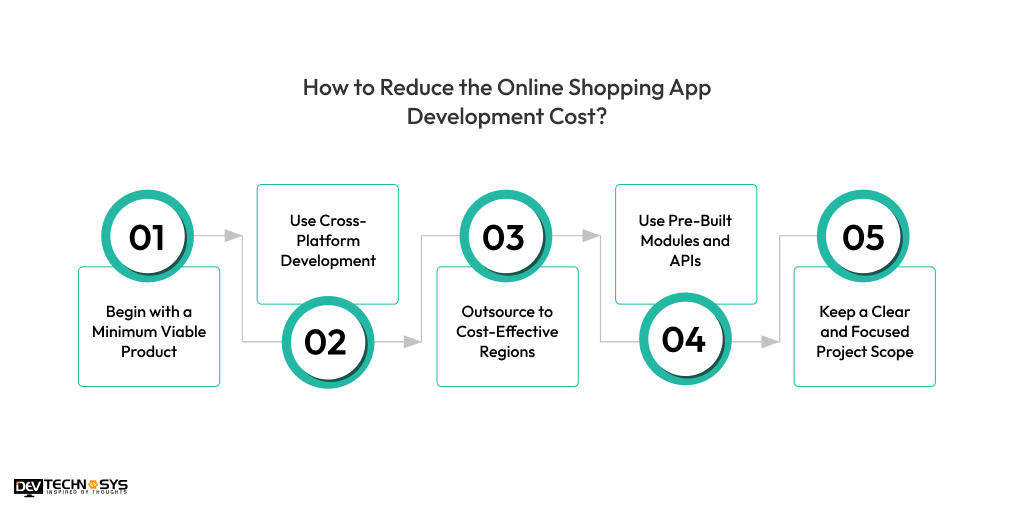
1. Begin with a Minimum Viable Product
Focus on building only the most important features for the initial launch. This allows you to test the app with actual users, get feedback, and avoid investing in superfluous features up front. An MVP helps to decrease startup expenditures while verifying the commercial potential of the product.
2. Use Cross-Platform Development
Instead of creating separate apps for iOS and Android, employ cross-platform technologies such as Flutter or React Native. These frameworks allow for a single codebase for both platforms, which dramatically reduces the cost to build an online shopping app while ensuring a consistent user experience across devices.
3. Outsource to Cost-Effective Regions
Hiring developers from Southeast Asia or Eastern Europe can significantly cut labor expenses while maintaining quality. These locations have qualified developers at lower hourly rates than the US or UK, allowing your budget to stretch farther while retaining professional standards.
4. Use Pre-Built Modules and APIs
Rather than creating everything from scratch, leverage pre-built solutions for payment gateways, authentication, and product listings. Using APIs and third-party services speeds up development, lowers costs, and assures that crucial components are safe, reliable, and tested in real-world circumstances.
5. Keep a Clear and Focused Project Scope
Uncertain requirements and frequent scope modifications can lead to delays and higher online shopping app development cost. By specifying your app’s goals, features, and timetable in advance, you may prevent costly changes, eliminate misunderstanding, and keep the development process on track and within budget.
How to Make Money From an Online Shopping App?
Online marketplace apps generate revenue through multiple streams including product sales, subscription plans, in-app advertising, featured listings for sellers, affiliate marketing, and transaction commissions. Offering premium features, loyalty programs, and partnering with third-party brands also boost monetization.
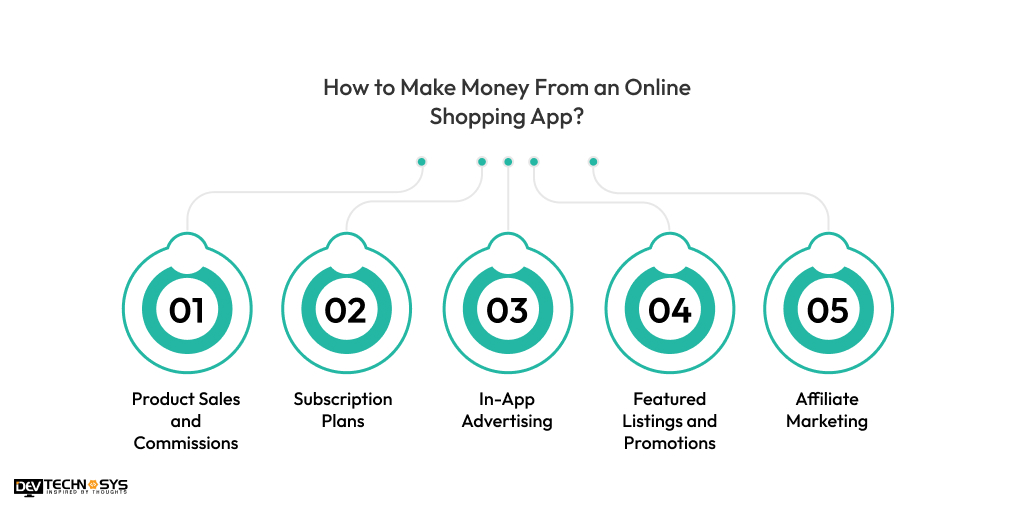
1. Product Sales and Commissions
The major business plan is to sell your own items or earn a commission from third-party vendors. In a marketplace approach, you can charge vendors a portion of each sale, resulting in a steady cash stream as sales volumes rise and more merchants join your platform.
2. Subscription Plans
Provide consumers with premium memberships that provide perks such as free delivery, early access to promotions, and unique discounts. Subscription models generate recurring income and promote consumer loyalty. Businesses may also provide sellers with premium subscriptions that include more exposure, analytics, and other app capabilities.
3. In-App Advertising
Integrate advertisements from third-party networks such as Google AdMob, or provide ad spaces directly to merchants and brands. You may charge for banner advertisements, sponsored listings, or push alerts. According to the mobile app development services provider, this strategy is effective for apps with high traffic and user interaction, resulting in passive revenue over time.
4. Featured Listings and Promotions
Charge sellers or companies for promoting their items through featured listings, homepage banners, or highlighted categories. This increases vendor exposure and generates additional income for you. It works especially well in a multi-vendor marketplace where merchants are fiercely competitive.
5. Affiliate Marketing
Partner with companies and earn commissions by sending customers to external stores or product pages via affiliate links. You are rewarded for traffic, clicks, and completed sales. This method is effective for product discovery or review-based shopping apps that do not manage inventories or transactions directly.
Conclusion
In conclusion, the cost to develop an online shopping app in UAE depends on factors like features, platform, developer location, and app complexity. Whether you’re building a basic store or a feature-rich marketplace, planning and budgeting are essential.
Partnering with an experienced online shopping app development company in Dubai can ensure high-quality results tailored to your business needs. Their regional expertise and competitive pricing make Dubai a strategic choice for businesses looking to build scalable and user-friendly eCommerce solutions efficiently.
Frequently Asked Questions
1. How Much Does It Cost To Develop an Online Shopping App in UAE?
The cost to develop an online shopping app in UAE ranges from $8,000 to $25,000 or more, depending on features, complexity, platform, and the location and expertise of the development team.
2. How Much Time Does It Take to Create an Online Shopping App?
To create an online shopping app mainly takes 3 to 6 months, depending on the app’s complexity, features, design requirements, platform choice, and the experience level of the development team involved.
3. Does the Cost Differ for iOS and Android Apps?
Yes, the cost differs. Developing separate native apps for iOS and Android increases expenses due to distinct codebases. Using cross-platform frameworks like Flutter can reduce costs by enabling shared development for both platforms.
4. How Much Does it Cost to Maintain a Virtual Shopping App?
Maintaining an product purchase app typically costs 15–20% of the initial development cost annually. This includes server hosting, bug fixes, updates, security patches, and ongoing support to ensure optimal performance.
5. How Much Does it Cost to Hire Shopping App Developers?
The cost to hire shopping app developers varies by location and expertise. Rates typically range from $15 to $25 per hour, with lower costs in regions like Southeast Asia and Eastern Europe and higher in North America.



